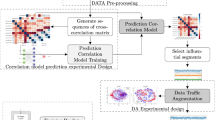Abstract
Time-series analysis plays a crucial role in extracting meaningful patterns from sequential data, serving to gain insights into temporal trends. Specifically, the burgeoning urbanization trend accentuates the urgency of traffic forecasting in modern cities due to its socio-economic and environmental impact. While Deep Learning techniques, notably Long Short-Term Memory (LSTM) networks, have shown promise in predicting traffic, they often overlook contextual factors like weather and holidays. To address this challenge, this paper proposes a hybrid model combining LSTM with categorical and continuous data to forecast traffic volume on the Interstate 94 American highway. Incorporating weather, temporal patterns, and holidays, this study explores the performance of a model that includes contextual factors against standalone LSTM. The results show superior predictive accuracy for the proposed hybrid model. SHapley Additive exPlanations (SHAP) analysis reveals the influence of diverse features, emphasizing the significance of contextual attributes in enhancing traffic prediction.
G. Guerrero-Contreras, A. Muñoz, J. Boubeta-Puig—Contributing authors.
Access this chapter
Tax calculation will be finalised at checkout
Purchases are for personal use only
Similar content being viewed by others
References
Choi, K., Yi, J., Park, C., Yoon, S.: Deep learning for anomaly detection in time-series data: review, analysis, and guidelines. IEEE Access 9, 120043–120065 (2021)
Zhang, H., Sun, B., Peng, W.: A novel hybrid deep fuzzy model based on gradient descent algorithm with application to time series forecasting. Expert Syst. Appl. 238, 121988 (2024)
Méndez, M., Merayo, M.G., Núñez, M.: Machine learning algorithms to forecast air quality: a survey. Artif. Intell. Rev. 56(9), 10031–10066 (2023)
Boukerche, A., Tao, Y., Sun, P.: Artificial intelligence-based vehicular traffic flow prediction methods for supporting intelligent transportation systems. Comput. Netw. 182, 107484 (2020)
Ritchie, H., Roser, M.: Urbanization. Our World Data (2018)
Medina-Salgado, B., Sanchez-DelaCruz, E., Pozos-Parra, P., Sierra, J.E.: Urban traffic flow prediction techniques: a review. Sustain. Comput. Inform. Syst. 35, 100739 (2022)
Muñoz, A., Martínez-España, R., Guerrero-Contreras, G., Balderas-Díaz, S., Bueno-Crespo, A.: A real-time traffic alert system based on image recognition: a case of study in spain. In: 2023 19th International Conference on Intelligent Environments (IE), pp. 1–7 (2023). IEEE
Bi, J., Zhang, X., Yuan, H., Zhang, J., Zhou, M.: A hybrid prediction method for realistic network traffic with temporal convolutional network and LSTM. IEEE Trans. Autom. Sci. Eng. 19(3), 1869–1879 (2021)
Fernandes, B., et al.: Traffic flow forecasting on data-scarce environments using ARIMA and LSTM networks. In: Rocha, Á., Adeli, H., Reis, L.P., Costanzo, S. (eds.) WorldCIST’19 2019. AISC, vol. 930, pp. 273–282. Springer, Cham (2019). https://doi.org/10.1007/978-3-030-16181-1_26
Balderas-Díaz, S., Muñoz, A., Guerrero-Contreras, G.: Optimization of traffic light controllers using genetic algorithms: a case study in the city of cádiz. In: International Symposium on Ambient Intelligence, pp. 103–112 (2023). Springer https://doi.org/10.1007/978-3-031-43461-7_11
Alves, R.M., Barbieri, L., Stroeh, K., Peres, S.M., Madeira, E.R.M.: Context-aware completion time prediction for business process monitoring. In: World Conference on Information Systems and Technologies, pp. 355–365 (2022). Springer https://doi.org/10.1007/978-3-031-04819-7_35
Antwarg, L., Miller, R.M., Shapira, B., Rokach, L.: Explaining anomalies detected by autoencoders using shapley additive explanations. Expert Syst. Appl. 186, 115736 (2021)
Acknowledgments
Financial support for this research has been provided under AwESOMe Project PID2021-122215NB-C33 and ALLEGRO Project PID2020-112827GB-I00, both funded by MCIN/ AEI /10.13039/501100011033/ and by ERDF A way to do Europe.
Author information
Authors and Affiliations
Corresponding author
Editor information
Editors and Affiliations
Rights and permissions
Copyright information
© 2024 The Author(s), under exclusive license to Springer Nature Switzerland AG
About this paper
Cite this paper
Balderas-Díaz, S., Guerrero-Contreras, G., Muñoz, A., Boubeta-Puig, J. (2024). Fusing Temporal and Contextual Features for Enhanced Traffic Volume Prediction. In: Rocha, Á., Adeli, H., Dzemyda, G., Moreira, F., Poniszewska-Marańda, A. (eds) Good Practices and New Perspectives in Information Systems and Technologies. WorldCIST 2024. Lecture Notes in Networks and Systems, vol 986. Springer, Cham. https://doi.org/10.1007/978-3-031-60218-4_8
Download citation
DOI: https://doi.org/10.1007/978-3-031-60218-4_8
Published:
Publisher Name: Springer, Cham
Print ISBN: 978-3-031-60217-7
Online ISBN: 978-3-031-60218-4
eBook Packages: Intelligent Technologies and RoboticsIntelligent Technologies and Robotics (R0)




